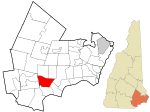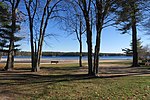Camp Tel Noar
Buildings and structures in Rockingham County, New HampshireHampstead, New HampshireJewish summer camps in New HampshireSummer camps in New Hampshire
Camp Tel Noar is a Jewish summer camp for children ages 7 through 16. It is located in Hampstead, New Hampshire, in the United States, which is about 1 hour north of Boston. The camp sits on Sunset Lake (Wash Pond) and has about 275 campers.
Excerpt from the Wikipedia article Camp Tel Noar (License: CC BY-SA 3.0, Authors).Camp Tel Noar
Cecil Avenue,
Geographical coordinates (GPS) Address Nearby Places Show on map
Geographical coordinates (GPS)
| Latitude | Longitude |
|---|---|
| N 42.885277777778 ° | E -71.188333333333 ° |
Address
Cecil Avenue 78
03841
New Hampshire, United States
Open on Google Maps











